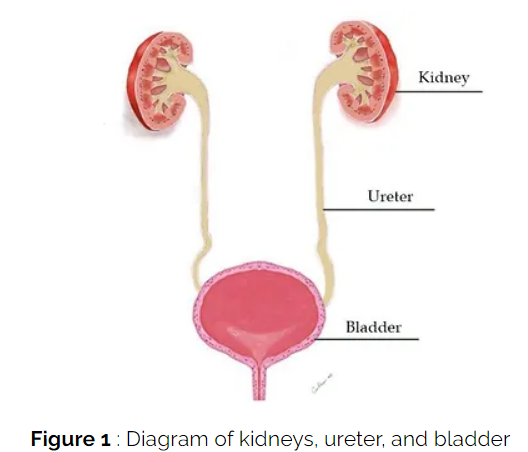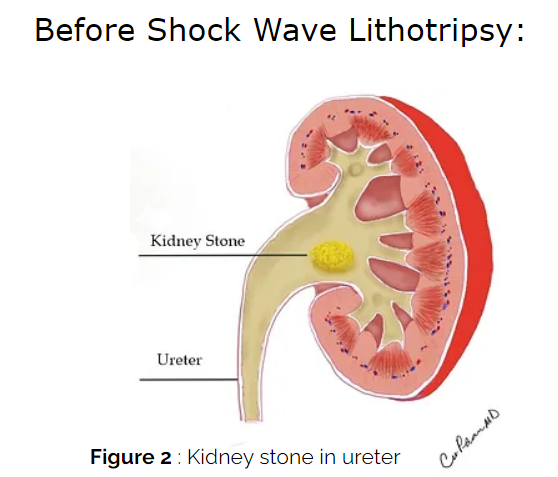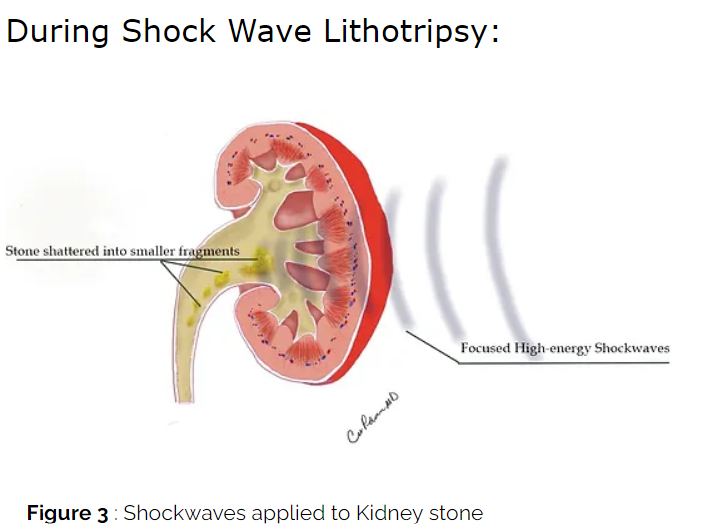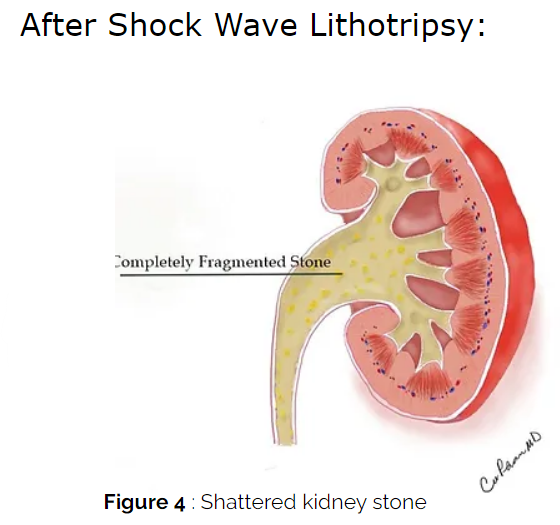What is Shock Wave Lithotripsy?
Shock wave lithotripsy is a common, noninvasive procedure used to treat kidney and ureteral stones. It is considered noninvasive because no incision is made through the skin. Shock wave lithotripsy breaks kidney stones by focusing high-energy shock waves on to the stones. The stones are localized using noninvasive imaging techniques such as ultrasound, or more commonly, fluoroscopy, which is a form of real-time x-ray.
Shock wave lithotripsy takes about one hour and is usually done in a hospital or in a surgery center as an outpatient procedure under deep sedation or general anesthesia.
How does Shock Wave Lithotripsy work?
Stone is located using non-invasive imaging techniques such as ultrasound or real time x-ray
Preparation
Your doctor will talk to you about the procedure, its indication, its risks, benefits, alternatives, and likelihood of success based on the size and location of the stone.
You will be given the opportunity to ask questions before you sign a consent form allowing the physician to perform the procedure.
Your doctor will do a history and physical exam and order diagnostic tests to make sure you are in good condition for the procedure.
Possible Complications and Risks
While Shock Wave Lithotripsy is considered safe, it can potentially cause complications, including but not limited to bleeding around the kidney, bruising, ureteral blockage with stone fragments, infection, and failure to fragment the stones.
Further procedures may need to be performed.
Contraindications
You should not have an Shock Wave Lithotripsy if you are pregnant, morbidly obese, have an obstruction beyond the stone, an abdominal aortic aneurysm (swelling of the aorta), urinary tract infection, or an uncorrected bleeding disorder.
Let your Doctor know...
The names and dosages of all medications that you are taking, including blood thinning medication (such as ibuprofen or aspirin), over-the-counter medications, and supplements.
Be sure to ask if you need to stop any of these medications prior to the procedure and, if so, how many days should you stop them before the procedure
Inform doctor of any allergies that you may have, including tape, latex, or contrast material
Inform doctor of any bleeding disorders that you may have
Inform doctor if you are/or suspect that you are pregnant
And be sure to...
Arrange for someone to drive you home after the procedure as you will be unable to drive after the deep sedation or general anesthesia
Not eat or drink anything at least 8 hours prior to the procedure. You may take your usual medications with tiny (a few teaspoons) of water, but no other fluids—not even milk or coffee.
Under deep sedation or general anesthesia, food or liquid may be aspirated into your lungs, jeopardizing your health
Ask when you should arrive to the surgical center or hospital for the procedure (usually ~ 1-2 hours prior)
Shockwave Lithotripsy Procedure:
You will be asked to remove your clothing and jewelry and to change into a gown.
An anesthesiologist, a physician who administers anesthesia, will meet with you to answer any questions you may have regarding sedation or anesthesia. An IV, intravenous line, will be inserted.
You will then be brought into the operative/procedure room and positioned onto a lithotripter table.
The anesthesiologist will administer deep sedation or general anesthesia to ensure that you will not experience any pain or discomfort.
Your urologist, will use either a fluoroscopy or an ultrasound unit attached to the lithotripter, will locate the stone.

Once the lithotripsy begins, high-energy shockwaves will travel through the water filled cushion located just beneath your back, through your body, and focus on the stone, fragmenting it into smaller pieces. The fragmentation of the stone will be monitored in real time using fluoroscopy or ultrasound. Generally, the lithotripsy procedure is finished once the stone is completely fragmented and can no longer be seen with fluoroscopy or when the maximum allowable number of shockwaves has been reached.
Per Dr. Fanning, "Sometimes it is necessary to place a ureteral stent at the time of the lithotripsy, especially if the stone is large."
As shown in Figure 7, a ureteral stent is a flexible tube about 10 inch long with holes in it that curls at each end. The stent connects from the kidney to the bladder. It may assist in locating the stone, in stone fragment passage, or in ensuring urine drainage from the kidney into the bladder. Ureteral stents are usually well tolerated but may cause frequent urination, bladder irritation, discomfort at the end of urination, or discomfort in the flank.

After the Lithotripsy...
You will be brought into a recovery room where you will be monitored for about 1-3 hours.
Then you will be sent home with pain medications and a urine strainer. The urine strainer is for you to strain your urine and collect any passing stone fragments.
You may experience pain when passing stone fragments. It may take a few days to several weeks to pass stone fragments. These stone fragments will be sent for stone analysis testing.
You will need to make a follow up appointment with your urologist in a few weeks. Remember to bring the stones you have collected.
At Home...
You may have dark or slightly bloody urine. You may resume normal activity in a few days.
Please go to the emergency room immediately if you have..
A fever over 101F or have chills. Usually this indicates you have an infection or possible obstruction of the urinary tract.
Please contact your urologist immediately if you have...
Severe bleeding
Intolerable pain
Persistent nausea & vomiting
Urinating problems








Comments